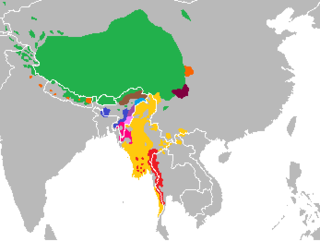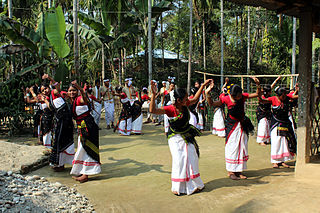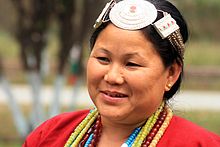
Lhoba is any of a diverse amalgamation of Sino-Tibetan-speaking tribespeople living in and around Pemako, a region in southeastern Tibet including Mainling, Medog and Zayü counties of Nyingchi and Lhünzê County of Shannan, Tibet.

Arunachal Pradesh is a state in northeast India. It was formed from the North-East Frontier Agency (NEFA) region, and India declared it as a state on 20 February 1987. Itanagar is its capital and largest town. It borders the Indian states of Assam and Nagaland to the south. It shares international borders with Bhutan in the west, Myanmar in the east, and a disputed 1,129 km border with China's Tibet Autonomous Region in the north at the McMahon Line. Arunachal Pradesh is claimed in its entirety by China as South Tibet as part of the Tibet Autonomous Region; China occupied some regions of Arunachal Pradesh in 1962 but later withdrew its forces.

The Sherdukpen are an ethnic group of Arunachal Pradesh state of India. Their population of 9,663 is centered in West Kameng district in the villages of Rupa, Jigaon, Thongri, Shergaon, to the south of Bomdila. All of these are at elevations between 5000 and 6000 feet above sea level. Of late, some of them have settled in Kameng bari areas, a new settlement area under Bhalukpong circle.
The Buguns are one of the earliest recognized schedule tribe of India, majority of them, inhabiting the Singchung Sub-Division of West Kameng District of Arunachal Pradesh. Buguns live in several exogamous clans. Traditionally, the predominant occupation was agriculture, supported with other allied activities like fishing and hunting, cattle rearing etc. Buguns have their own folklores, songs, dances, music and rituals. A rare bird, the Bugun liocichla, was named after the tribe.

The Miji, are a social group of Arunachal Pradesh, India. They are located in various districts of Arunachal Pradesh including the West Kameng, East Kameng and Kurung Kumey.Their population of 37,000 are found near the lower parts of the sub-Himalayan hills bordering Assam; they speak the Sajalong language.
The Indian state of Arunachal Pradesh has a total population of roughly 1.4 million on an area of 84,000 km2, amounting to a population density of about 17 pop./km2. The "indigenous groups" account for about two thirds of population, while immigrants, mostly of Bengali/Hindi belt origin, account for the remaining third.
East Kameng district is one of districts of Arunachal Pradesh state in northeastern, India. It shares an international border with China in the north and district borders with West Kameng district to the west, Pakke-Kessang district to the south, Kurung Kumey district to the east, Papum Pare district to the southeast. Pakke-Kessang district was bifurcated from East Kameng district on 1 December 2018.

The Wancho people, also known as the Wancho Naga, are a Tibeto-Burmese indigenous ethnic group inhabiting the Patkai hills of Longding district in the Northeast Indian state of Arunachal Pradesh. The Wancho language belongs to the Tibeto-Burman family under Northern Naga languages.
The Tani language, often referred to as Tani languages, encompasses a group of closely related languages spoken by the Tani people in the northeastern region of India, primarily in the state of Arunachal Pradesh and Assam. These languages belong to the Sino-Tibetan family and include several major dialects such as Nyishi, Galo, Apatani, Adi, Tagin, and Mising.

Bodo–Kacharis is a name used by anthropologists and linguists to define a collection of ethnic groups living predominantly in the Northeast Indian states of Assam, Tripura, Meghalaya and West Bengal. These peoples are speakers of either Bodo–Garo languages or Assamese. Some Tibeto-Burman speakers who live closely in and around the Brahmaputra valley, such as the Mising people and Karbi people, are not considered Bodo–Kachari. Many of these peoples have formed early states in the late Medieval era of Indian history and came under varying degrees of Sanskritisation.
The Hrusish or Southeast Kamengic languages possibly constitute a Sino-Tibetan branch in Arunachal Pradesh, northeast India. They are Hruso (Aka) and Mijiic. In Glottolog, Hammarström, et al. does not accept Hrusish, and considers similarities between Hruso and Miji to be due to loanwords.

The Tibeto-Burman languages are the non-Sinitic members of the Sino-Tibetan language family, over 400 of which are spoken throughout the Southeast Asian Massif ("Zomia") as well as parts of East Asia and South Asia. Around 60 million people speak Tibeto-Burman languages. The name derives from the most widely spoken of these languages, Burmese and the Tibetic languages, which also have extensive literary traditions, dating from the 12th and 7th centuries respectively. Most of the other languages are spoken by much smaller communities, and many of them have not been described in detail.

Deori is a Tibeto-Burman language in the Tibeto-Burman languages family spoken by the Deori people of Assam and Arunachal Pradesh. Deori are also a part of Bodo–Kachari people. Among the four territorial groups only the Dibongiya have retained the language. The others—Patorgoyan, Tengaponiya, and Borgoyan—have shifted to Assamese. It is spoken in Lohit district of Arunachal Pradesh, and in Lakhimpur, Dhemaji, Tinsukia, Sivasagar and Jorhat districts of Assam. The primary literary body of Deori is known as "deori chucheba chengcha".
Koro is a language spoken in Arunachal Pradesh, India. It is typically classified as a Sino-Tibetan language, and has some resemblances to Tani farther to the east. It has been argued that Koro is actually part of the Greater Siangic family, independent from but influenced by the Sino-Tibetan family. Koro is spoken by about 1,500 people in the Koro-Aka tribe who are found in East Kameng District, Arunachal Pradesh, northeast India. Few speakers are under 20 years old. The majority of Koro speakers live in bilingual households in which one or more members speak Ako or another indigenous language rather than Koro. The Koro-Aka tribe lives among the Aka (Hruso) tribe. However, the Koro-Aka people speak a very distantly related language from the remaining Aka tribe who speak Hruso-Aka. Researchers hypothesize Koro may have originated from a group of people enslaved and brought to the area.
The Puroik language is a possible language isolate spoken by the Puroik people of Arunachal Pradesh in India and of Lhünzê County, Tibet, in China.
Miji, also given the dialect names Sajolang and Dhammai, is a dialect cluster traditionally counted as one of the Sino-Tibetan languages that is spoken in Arunachal Pradesh, northeastern India. The varieties are not particularly close, with only half of the vocabulary in common between the languages of East Kameng District and West Kameng District. Long assumed to be Sino-Tibetan languages, Miji and the recently discovered Bangru language may instead form a small independent language family.
Nefamese or Arunamese is a pidgin of Arunachal Pradesh, India. Its classification is unclear; Ethnologue states that it is based on the Assamese language, but also that it is most closely related to the Sino-Tibetan Gallong like the Assamese language formed out by the mixture of languages like Austroasiatic, Tibeto-Burman, Tai and Indo-European family of languages.
The Barman Kacharis are an indigenous community of Northeast India and are a subsection of the Dimasa people in Barak Valley but claim to a separate group in Brahmaputra Valley. They are mainly found in the districts of Lower Assam and in Barak Valley like Cachar, Hailakandi and Karimganj and some parts of Arunachal Pradesh. Barman Kachari is Dimasa convert group of North-East India. Since the 2002 Amendment act, many Barman Kacharis in Assam are referred to as 'Barman'. They are sparsely found in Brahmaputra valley.

Pakke-Kessang is a district located in the state of Arunachal Pradesh in the Northeast of India. The district used to be a part of the neighboring district, East Kameng, and has been created out of its five southernmost administrative units: Pijerang, Passa Valley, Pakke-Kessang, Dissing Passo and Seijosa. The district headquarters of Pakke-Kessang is located at Lemmi.

The Moran are an ethnic group found in the northeast Indian states of Assam and Arunachal Pradesh. They are of Tibeto-Burman origin and belong to the Kachari family. They speak Assamese language, though they used to speak Moran language which was alive until the early 20th century and was closely related to the Dimasa language. They once shared the same allied customs with other Kachari groups, but after their conversion to Vaishnavism, the customs began to diminish, but still, those customs can be seen intermixed with Vaishnavism.












